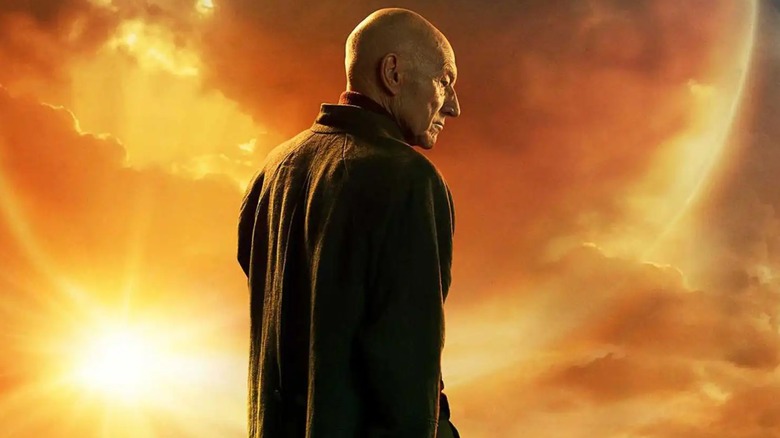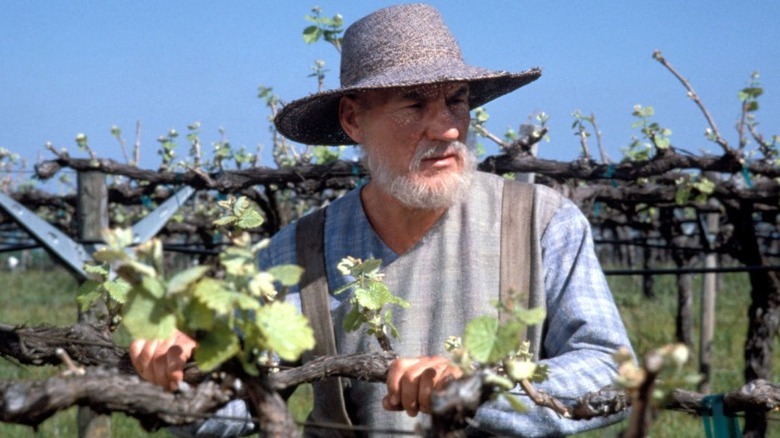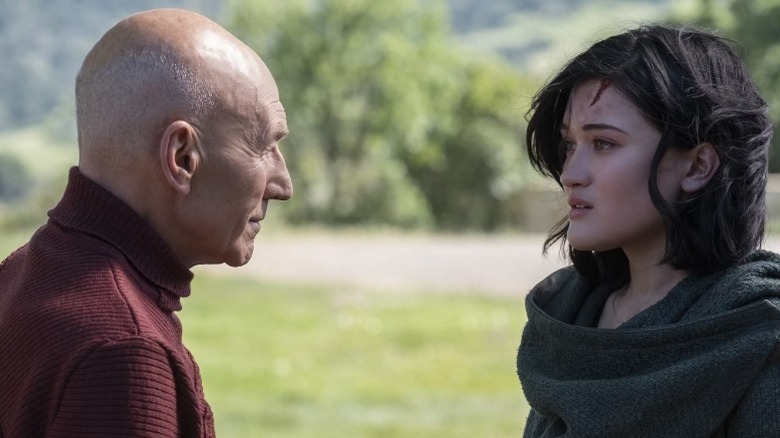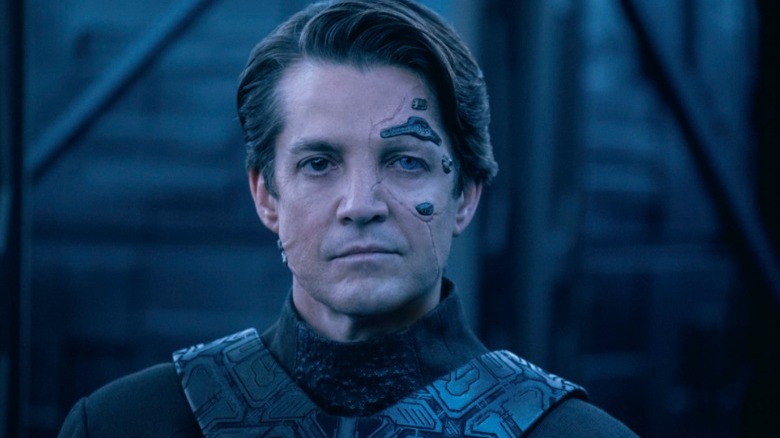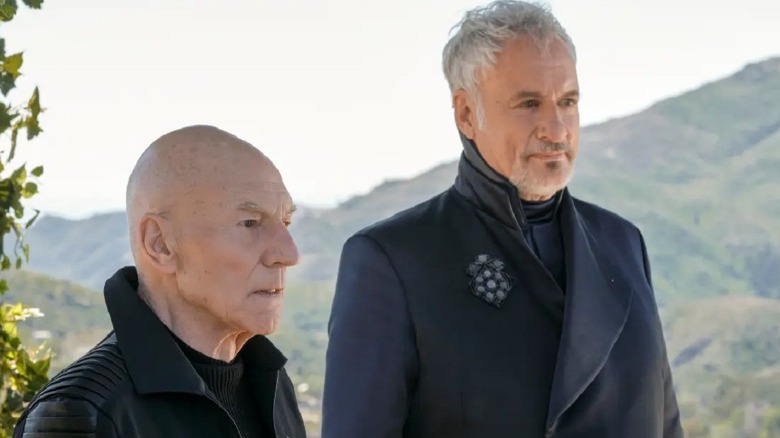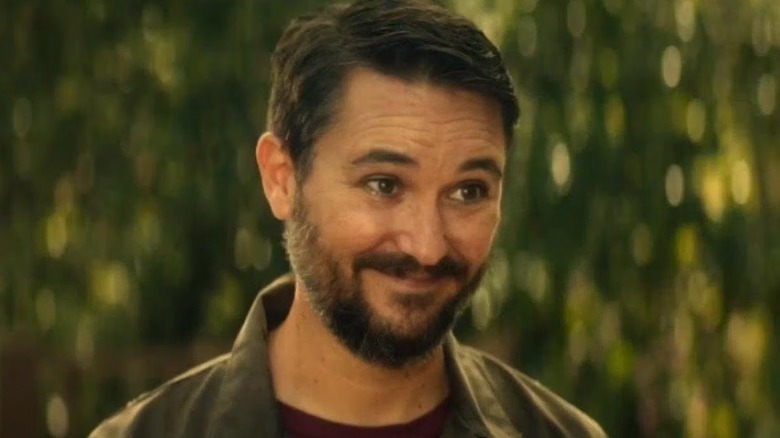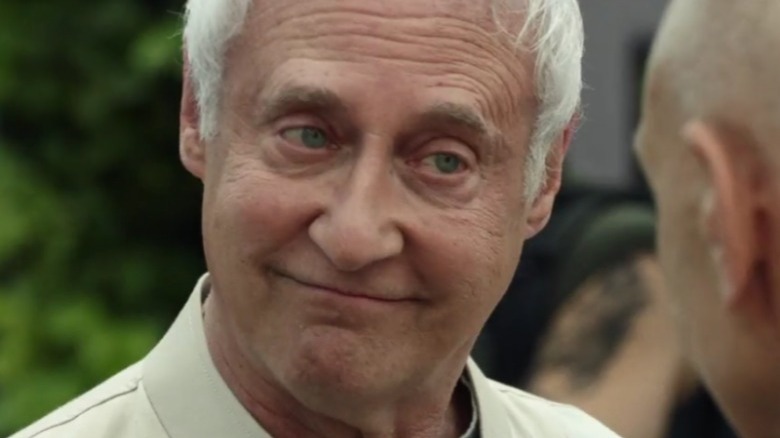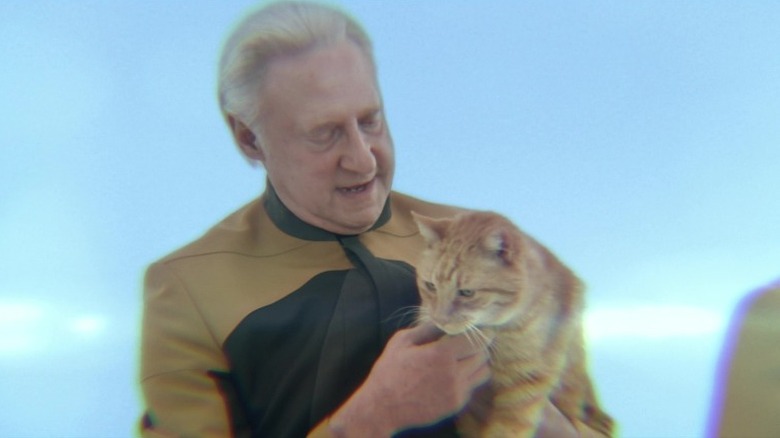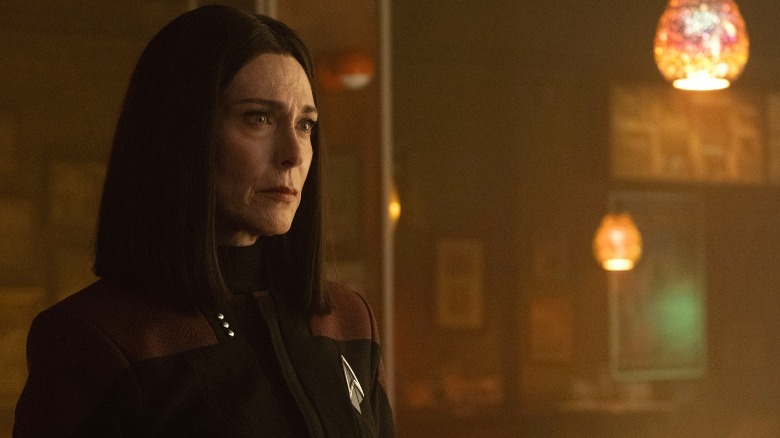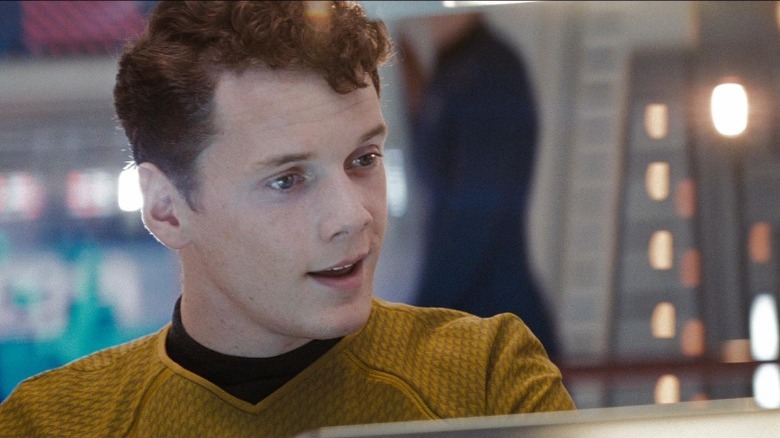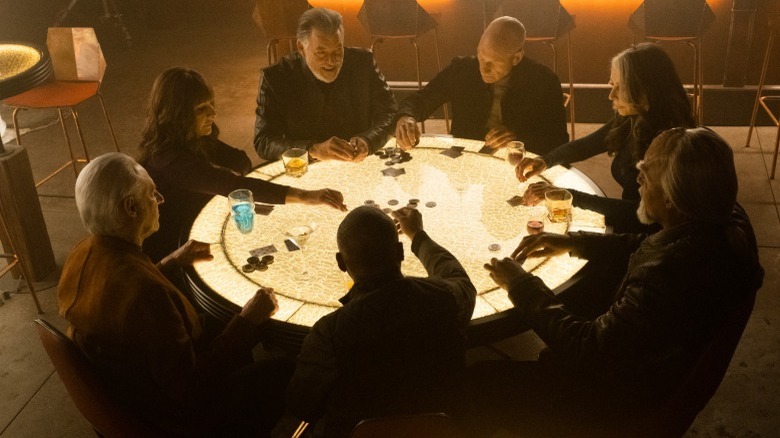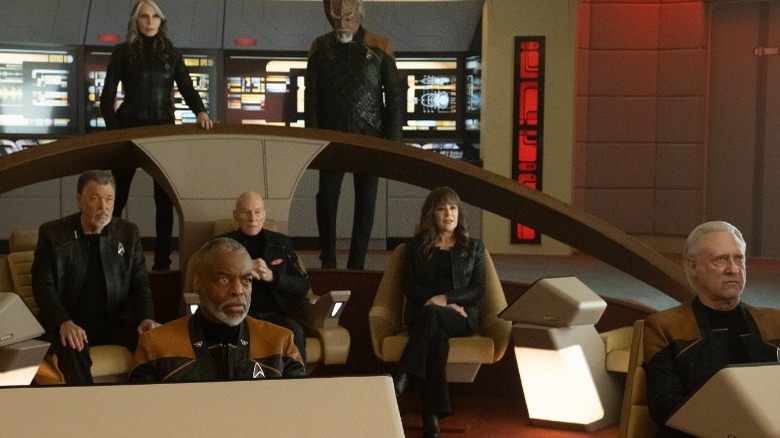Star Trek: Picard's 11 Most Nostalgic Moments
"Star Trek: Picard" didn't start its journey as a festival of nostalgia for "Star Trek: The Next Generation" fans. Star and producer Sir Patrick Stewart was upfront about wanting to tell new stories about the stately Admiral Picard in the years since he was the captain of Enterprise-D. By the third season, "Picard" showrunner Terry Matalas convinced Stewart through his actions that the series was great, but nostalgia and fan service aren't always bad things.
The final season turned into a treat for "Next Gen" fans, as Admiral Picard rounded up almost the entire Bridge Crew for one more adventure, and it also served up arguably the best storyline of the series. But through all three seasons, there was plenty on offer to make a "Star Trek" devotee happy, bringing back deep cuts of lore and reminding us of some iconic episodes. To celebrate a full series well told — and to hope, like many of us, that we'll see the rumored "Star Trek Legacy" spinoff — we're looking back at the most nostalgic moments in "Picard." Raise your glass of Romulan ale and let's boldly go!
Revisiting Chateau Picard
Keep that Romulan ale on standby, because while "Star Trek: Picard" whisks us back to the French countryside of Picard's ancestral home early in the series, it's also a running joke that the wine it produces is not that tasty to most of his friends' palates. But that's beside the point for "Star Trek: The Next Generation" fans who know that one of the best two-parters in the series, "The Best of Both Worlds," is followed up with visiting these vineyards during one of the most emotional episodes in Jean-Luc Picard's life. It's good to see these fields again, even if the circumstances are just as fraught as ever.
"Family" is the first time we see a glimpse of what Picard would have been as a child, at odds with his brother Robert (Jeremy Kemp), rambling among the grape vines. "Picard" wakes Jean-Luc from a nightmare of the past in its premiere episode, eventually taking us on a tour of the old estate. Season 2 keeps an even tighter focus on the ancestral territory, as Picard's childhood memories explore dark parts of the manor fans never even suspected could exist. It's a great visit, and the nostalgia keeps on giving. You can even buy a bottle of Picard's wine online today.
Bruce Maddox and Data's daughters
Soji and her twin sister Dahj (Isa Briones) are in a tough place as "Star Trek: Picard" starts rolling into high gear. Dahj is haunted by confusing memories that lead her toward Admiral Picard and her death, and Soji is drawn into a net of self-doubt and the same growing confusion. The big reveal of the Asha twins feels obvious to fans of Lt. Commander Data's best "Star Trek: The Next Generation" episodes because these girls even look a little like his first daughter, Lal. A portrait painted by Data that hangs in Picard's manor makes the connection clearer.
The genesis of the secret Coppelius androids lies not just with another member of Data's extended Soong family but with a respected frenemy named Dr. Bruce Maddox (Brian Brophy in "TNG"; John Ales in "Picard"). Maddox isn't long for the world when he shows up in "Picard," but his attitude is a far cry from the self-assured jerk he was back in "The Measure of a Man." Now one of the chief researchers of synthetic science, he's sympathetic to the troubles humanoid androids are facing — too sympathetic to be allowed to survive. It was still good to have him back and to know that Data's daughter lives on in a new way.
Hugh, the independent Borg
"Star Trek" is at its best when it digs deep into the behaviors of its fiercest foes, from the Klingons to the Romulans. The Borg had a layer of impenetrability to them, and their collective mind kept viewers from finding much to empathize with, especially after they tried to assimilate Picard into the cruel puppet Locutus. However, "I, Borg" changed the stakes with a drone sundered from the hive, forcing the Enterprise crew to challenge their assumptions about the Borg's victimized members.
Hugh (Johnathan Del Arco) had an innocence to him that helped save the day in a later appearance on "Star Trek: The Next Generation," but it's his return in "Star Trek: Picard" that's a delight for longtime fans. Older and more human than ever, Hugh is heading up a Borg Artifact Research Institute dedicated to helping ex-Borg like himself and Seven of Nine reacclimatize to life as an individual. It's unfortunate that he's killed off before the season ends, as the fan-favorite Hugh was a hopeful, kind figure that reminded us of what's worth fighting for.
Q returns
The omnipotent pain in everyone's backside, Q (John de Lancie), opens and closes "Star Trek: The Next Generation" with a trial to determine humanity's value in the universe. In between, his appearances on the Enterprise's bridge are some of the series' best moments. One of the most beloved characters in "Star Trek," with appearances on "Deep Space 9" and "Lower Decks," fans hoped it would only be a matter of time before Q appeared before the elder Picard. "Star Trek: Picard" Season 2 gave us Q back in spades, with a wobbly but heartfelt story about failure, death, and acceptance.
In a nod to his immortality, Q is first seen as we remember him: in the Enterprise's command red uniform and curly dark hair. He ages himself gracefully into a silver-haired devil, and, as usual, his newest game initially seems full of menace. But it's not about being evil, and Q's twisty story is his idea of reaching out to Jean-Luc as the friend he always was. And while the "Picard" Season 2 finale is bittersweet, with an immortal's life coming to an end, time is not linear for the Continuum. There's a hint and maybe a promise that Q, sneaky and silly as ever, will make time for Picard's son in the future.
Travelers and Supervisors
There are a few deep cuts in "Star Trek" lore. One of them is knowing that a strange man named Gary Seven (Robert Lansing) is part of a secretive group of timeline police called Supervisors and that his original series episode, "Assignment: Earth," was going to spin off into its own show. That never happened, and the Supervisors never came back up in canon. However, "Star Trek: The Next Generation" introduced the Travelers, beings attuned to time and space in mystical ways. By the end of the series, Wesley Crusher (Wil Wheaton) has taken off on a journey at the side of one of their members.
"Star Trek: Picard" brought both these threads together at last, with Tallinn (Orla Brady) revealing herself not to be a doppelgänger of Jean-Luc's Romulan romance but a true Supervisor, assigned to ensure Picard's ancestor, Renee Picard, completes a space flight necessary to humanity's future survival. The season finale goes all in on serving up a lore fan's full meal, revealing that Wesley Crusher has completed his training and is now a full Supervisor himself, busy tying up loose threads throughout history.
The Soong family
You can't stop Brent Spiner from stealing the show. Funnier and far more eccentric in person than you'd guess from decades of watching Lt. Commander Data straight-face his way through another improbable scenario, "Star Trek" is happy to give the actor roles as Data's extended and extremely varied family. In "The Next Generation," Spiner sometimes played two or three versions of the Soong family at once, going so far as to put Data, Lore, and their cyberneticist patriarch Noonian Soong (no, not Khan) at odds in the same scene. "Star Trek: Picard" delightfully ups the ante.
"Picard" Season 1 brings in Altan Soong, the previously unknown son of Noonian, now working with Bruce Maddox to perfect and protect the Coppelius androids. Season 2 went back in time to the ancestor Adam Soong, letting Spiner play a frantic, weaselly, and easily angered member of the clan whom Q manipulates into a wannabe villain. Then in Season 3, though we don't see much of him, Altan Soong returns to reveal one of the biggest joys of the entire season. It's always great to see the Soongs because more Brent Spiner is better than less.
Data – and Spot too!
Data quickly appears in "Star Trek: Picard" Season 1 as part of a dream that's been haunting Jean-Luc for years since the synthetic assault on Mars. This season ends with a melancholy nostalgia, as we find that Bruce Maddox protected a copy of Data's positronic brain for decades, ready to be installed into a new form. This Data, however, is ready to learn about mortality, and his willingness to let go gives Picard a new lease on life.
Season 3 spins Data's quest for humanity in a new direction. Altan Soong had one more unfinished project locked away in the Daystrom facilities. It's an android body that looks older and more human than ever (Brent Spiner knows age comes for us all), but its mind is frozen in a fight between Data and Lore. To get Data back, LaForge (Levar Burton) puts the battle in motion once more. It's decades of learned kindness, sacrifice, and loyalty that puts Data on top by the end — along with his memories of the unconditional love of his cat, Spot. For those of us that grew up loving the "Star Trek: The Next Generation" episodes of Data trying to teach his cat to stay off desks, it's a heart-swelling tearjerker to see how much this feline friend truly meant to Data.
Ro Laren
Ro Laren (Michelle Forbes) was our introduction to the nuances of the Maquis resistance during the height of the "Star Trek: The Next Generation" era Bajoran-Cardassian conflict. Although the original hope was to bring Ensign Ro to "Star Trek: Deep Space Nine," fate had other plans. For decades, our last sight of Ro was her well-intentioned but heartbreaking betrayal of her Enterprise friends, all for the sake of her people.
"Star Trek: Picard" gave us a big surprise in the third season when Worf's intelligence handler — and a major intel operative in her own right — was Commander Ro Laren. Quietly brought back into the fold after her arrest as a Maquis terrorist, her first verbal clashes with former mentor Picard were familiar and aching. The only regret is that we lost her too quickly, as she sacrifices herself to buy Picard time to stop a Changeling plot. At least in "Star Trek," like many other stories, people have a way of coming back despite the odds. We can hope, anyway. Ro Laren remains one of the franchise's best characters, regardless of how short her time was.
President Anton Chekov
The Chekov lineage has been part of our hearts since Ensign Pavel Chekov (Walter Koenig) brought a cute Monkees style and soft Russian accent to the original Enterprise bridge. Whatever we may feel about the J.J. Abrams-helmed Kelvin Timeline movies, there's little argument that the casting of every major character – sit down, Khan – was on point. Their alternate universe version of Chekov honored Koenig with Anton Yelchin, a brilliant young actor who nailed Koenig's wide-eyed innocence and dry sense of humor.
"Star Trek" has shown us its Federation leaders in the past, with Kurtwood Smith's president in "The Undiscovered Country" and Jonathan Archer (Scott Bakula) at the end of the "Enterprise" era. "Picard" reveals that Pavel Chekov's son has taken the mantle of leadership, and it's his familiar voice that rallies a last stand against a horrifying new Borg assimilation strategy. It's not only a nostalgic nod to "Star Trek" history, but also a memorial. Pavel's presidential son — voiced by Walter Koenig himself — is named Anton, an obvious homage to Yelchin, who died in 2016.
A game of poker
Most series have a scene style used for character and plot development that feels unique. "Star Trek: The Next Generation" had the weekly poker game, introduced in "The Measure of a Man" as another method of humanizing Data and teaching him techniques like bluffing. It wasn't until the last moments of the series finale, "All Good Things," that Captain Picard joined the game. He'd long been invited, of course, but that was the hour that we knew "The Next Generation" was our family, and it was time for them to go.
"Star Trek: Picard" wraps up its final season with that same comfort in "The Last Generation." The losses ache. The day is won. And it's time for some well-earned rest as the cards splay out on a Ten Forward bar table in Los Angeles, as the game lasts long into the night. Fans might know this final scene is made from 45 minutes of the cast being themselves. It certainly feels that way to watch them, and the warmth they share makes us feel like we've been part of their game all along.
The bridge of the Enterprise-D
There's a long set of shots highlighting the Enterprise's beauty early in "Star Trek: The Motion Picture." When that movie premiered, seeing the classic ship up close in that much cinematic detail deserved what feels like a 20-minute Tarkovsky scene, although today, it does drag to watch. "Star Trek: Picard" has its own "My God, it's beautiful!" homage in "Vox," the series' penultimate episode, when LaForge at last unveils his secret garage project.
Seeing the bridge of the Enterprise-D in the classic warm light, with its carpeted floors and plush command chairs, is the finest, homiest bit of pure nostalgia we could have ever asked for. The scene runs a little long as the regathered crew admires LaForge's handiwork while the Borg are destroying the Alpha Quadrant from within, but frankly, it's also not long enough. The loveliest touch may be the familiar voice of Majel Barrett coming from the computer systems. Barrett, who was also the original Christine Chapel and Lwaxana Troi, left recorded samples of her voice behind for a day like this one. It was all a perfect gift to the fans, taking us on one more comfy ride.
